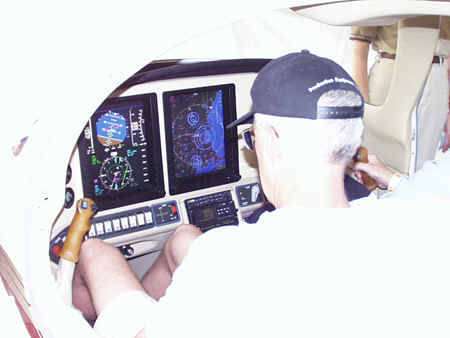
Initial public viewing of large-screen cockpit displays meets with enthusiastic response and validates company’s plans to develop general aviation “cockpit of the future.”
Lincoln, MA.—April 24, 2000, the unveiling of Avidyne’s developmental big-screen glass cockpit displays at the recent Sun ‘n Fun Fly-In in Lakeland, Florida, provided a glimpse of what is in store for general aviation cockpits of the future. Installed in a Columbia 300 mockup located in the Lancair exhibit, the dual 12.4-inch diagonal full-color displays featured a complete primary flight display (PFD) integrating attitude indicator, horizontal situation indicator, altimeter, airspeed indicator, vertical speed indicator, turn coordinator, moving map, and radio magnetic indicators (RMI). In addition, the multifunction display (MFD) showed a large-screen version of Avidyne’s award-winning FlightMax ä Flight Situation Display software including vector graphic moving maps, IFR and VFR charts,
Stormscope ä lightning, datalink weather, and traffic, with color-contoured terrain and water base map capability. This technology is the initial result of the NASA AGATE (Advanced General Aviation Transport Experiments) program to develop “Highway in the Sky” (HITS) technology for general aviation. These activities are being led by Avidyne and AvroTec, Inc. of Portland, Oregon. The Highway in the Sky contract calls upon Avidyne, AvroTec and their partners to design the general aviation aircraft cockpit of the future.

Products are expected to be certified sometime in 2001. “These displays represent several man-years of engineering development, and are an indication of what we hope to accomplish with the HITS program,” said Dan Schwinn, Avidyne’s president. “Public response to this new technology was overwhelming. We are clearly on the right track as we move forward in our mission to make Avidyne’s open-systems display technology the standard in all cockpits.” The Advanced General Aviation Transport Experiments (AGATE) Alliance (http://agate.larc.nasa.gov) is a unique partnership of public and private interests committed to improving safety in general aviation and to revitalizing the U.S. small aircraft industry. Under the leadership and sponsorship of NASA and FAA, more than 70 American companies have joined forces and shared resources to establish new standards and to validate emerging technologies for single-engine/single-pilot airplanes. The AGATE Alliance aims to make these airplanes as safe and economical as automobiles for trips typically ranging from 200 to 1000 miles, as an alternative to further gridlock on the nation’s automobile highways and hub-and-spoke commercial aviation airports.
NASA’s vision for these investments is to revolutionize mobility for Americans in the 21st century, beyond inter-city travel between 500 airports served by airlines to include over 5,000 general aviation airports throughout the nation. Through the unique partnership forged by the AGATE Alliance, public research funding is matched by private companies, and results are shared through standard setting and regulatory process. Since its initiation in 1994, the private companies in the AGATE Alliance have invested over $30 million and introduced innovations including improved training, better certification of manufacturing processes, easy-to-use engine controls, improved weather avoidance systems and improved navigation displays.
Together with a parallel program – the General Aviation Propulsion Program (GAP) at NASA’s Lewis Research Center in Cleveland, Ohio, for development of revolutionary engines – AGATE is providing industry partners with the technologies leading to a Small Aircraft Transportation System (SATS) in the early 21st century.